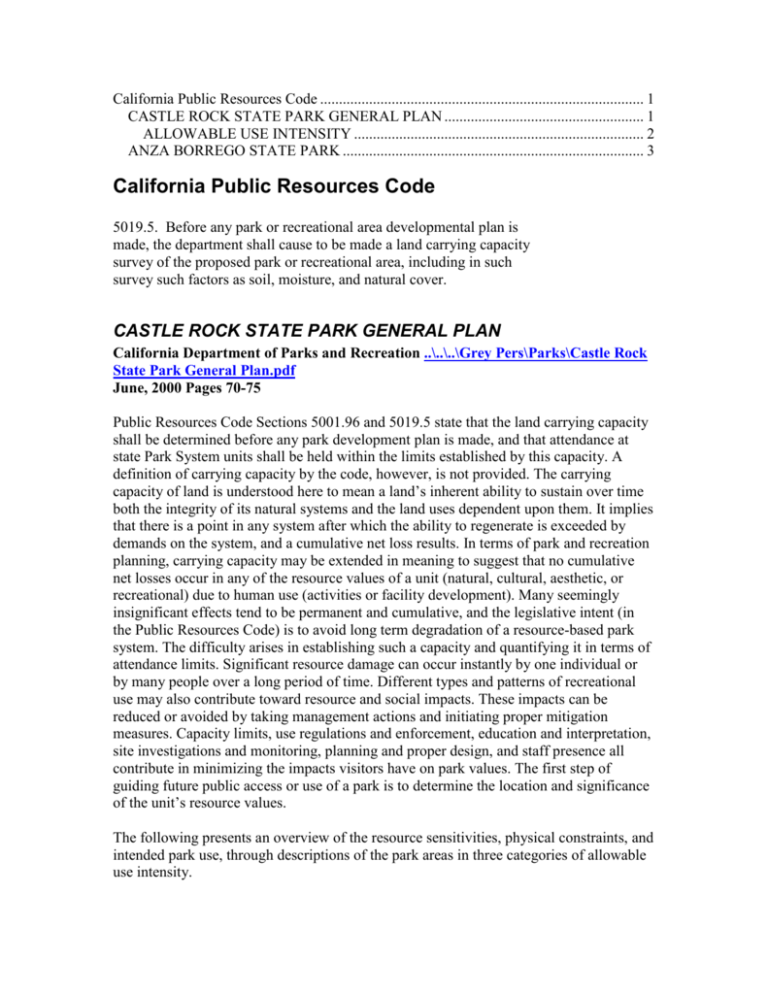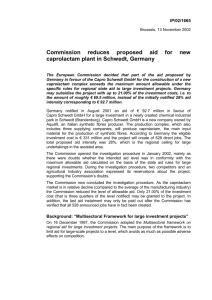Carrying Capacity Analysis
advertisement

California Public Resources Code ...................................................................................... 1 CASTLE ROCK STATE PARK GENERAL PLAN ..................................................... 1 ALLOWABLE USE INTENSITY ............................................................................. 2 ANZA BORREGO STATE PARK ................................................................................ 3 California Public Resources Code 5019.5. Before any park or recreational area developmental plan is made, the department shall cause to be made a land carrying capacity survey of the proposed park or recreational area, including in such survey such factors as soil, moisture, and natural cover. CASTLE ROCK STATE PARK GENERAL PLAN California Department of Parks and Recreation ..\..\..\Grey Pers\Parks\Castle Rock State Park General Plan.pdf June, 2000 Pages 70-75 Public Resources Code Sections 5001.96 and 5019.5 state that the land carrying capacity shall be determined before any park development plan is made, and that attendance at state Park System units shall be held within the limits established by this capacity. A definition of carrying capacity by the code, however, is not provided. The carrying capacity of land is understood here to mean a land’s inherent ability to sustain over time both the integrity of its natural systems and the land uses dependent upon them. It implies that there is a point in any system after which the ability to regenerate is exceeded by demands on the system, and a cumulative net loss results. In terms of park and recreation planning, carrying capacity may be extended in meaning to suggest that no cumulative net losses occur in any of the resource values of a unit (natural, cultural, aesthetic, or recreational) due to human use (activities or facility development). Many seemingly insignificant effects tend to be permanent and cumulative, and the legislative intent (in the Public Resources Code) is to avoid long term degradation of a resource-based park system. The difficulty arises in establishing such a capacity and quantifying it in terms of attendance limits. Significant resource damage can occur instantly by one individual or by many people over a long period of time. Different types and patterns of recreational use may also contribute toward resource and social impacts. These impacts can be reduced or avoided by taking management actions and initiating proper mitigation measures. Capacity limits, use regulations and enforcement, education and interpretation, site investigations and monitoring, planning and proper design, and staff presence all contribute in minimizing the impacts visitors have on park values. The first step of guiding future public access or use of a park is to determine the location and significance of the unit’s resource values. The following presents an overview of the resource sensitivities, physical constraints, and intended park use, through descriptions of the park areas in three categories of allowable use intensity. ALLOWABLE USE INTENSITY Allowable use intensity correlates the significance, sensitivities, and constraints of the unit’s resources with an allowable degree of disturbance due to human impacts. These uses may be defined by human activities and/or development of facilities. Allowable use intensity designations consider past, present, and future uses, and are used as planning tools in assessing the appropriateness of future proposals. The Allowable Use Intensity Map (Figure 2) illustrates which areas are included in each allowable use category. Low Allowable Use Intensity - Category I In Category I areas determined to have a low allowable use intensity, important resource values are especially vulnerable to impacts from activities and development. This category encompasses significant geologic features in pristine and near-pristine conditions and areas with high ecological sensitivities such as rare and endangered flora, rare natural communities, threatened and endangered wildlife and aquatic life, and important habitats for these species. Category I includes those areas that are moderate to severely constrained by soil and hydric conditions, and/or geologic hazards. Any allowable uses must be subordinate to the integrity of these resource values. Restoration or enhancement of resources shall be undertaken in situations where past or current uses have undermined them. For the most part, no facility development shall be allowed in these areas, with the exception of appropriate trail development. Well designed trails serve an important role in ultimate protection and appreciation of resource values. Sight-seeing, hiking, and nature study are representative of appropriate activities for this category. Moderate Allowable Use Intensity - Category II Moderate allowable use intensity in category II areas include those moderate to severely constrained by soil conditions such as slope and erosion conditions when exposed; hydric conditions such as seasonal flooding, 100-year floods, and/or geologic hazards such as fault zones. Ecologically sensitive areas in this category are those with native plant communities that help define the character of the unit, and that provide habitat for native wildlife, and spot locations of sensitive flora and fauna. Moderately sensitive cultural resources such as historic features of undetermined importance are included in this category also. Appropriate facilities in the moderate use intensity category include such uses as trails, roads, primitive trail camps, small structures for interpretation and rest stops, and low impact rock climbing outside the natural preserve and where appropriate as determined through a climbing management plan. Provision for such uses will be designed to avoid or minimize impacts on natural and cultural resources. All other uses and activities compatible with Category I areas are appropriate here. High Allowable Use Intensity - Category III Lands of higher allowable use intensity in Category III are not, or are only slightly, constrained by soil conditions, hydric conditions, or geologic hazards, although seismic activity and severity are difficult to predict. In this category are areas with less ecological sensitivities but that still contribute to the general character and appeal of the unit, such that larger scale disturbance in these areas would appreciably diminish the attractiveness and ambiance of the unit as a whole. Cultural resource sites and features with known slight sensitivities are included, as long as no major resource modifications are undertaken. Appropriate facilities in this high use intensity category are trails, roads, buildings and other facilities designed to blend esthetically with scenic, natural, and cultural features, and to avoid large-scale disturbance and minimize impacts. Parking availability, group activities, walk-in camping, administrative and maintenance functions, and all other compatible uses identified with Category I and II areas are appropriate in Category III. Allowable Use Intensity Map Application Not all areas in a category share the same characteristics or are affected in the same way by the conditions that may influence them. Therefore, the Allowable Use Intensity Map is useful only for general planning purposes. When site-specific proposals for land uses or facilities are to be prepared, the proposed location will be checked for resource constraints and sensitivities on various resource maps on file with the District, during the preliminary planning phases of the project. Site-specific investigations may also be necessary. ANZA BORREGO STATE PARK “The Plan” ..\..\..\Grey Pers\Parks\Anza borrego General Plan.pdf 2003 Carrying Capacity Park agencies, such as the U.S. Forest Service and the National Park Service, have long recognized that the management of visitor use requires data-based processes that respond to changing conditions. Carrying capacity is a dynamic process that adjusts and readjusts to changing conditions. Properly done, carrying capacity is not a static culmination of a focused, one-time, scientific research. The proper management of public use for the sake of resource protection and quality visitor experience must be dynamic, responding to changes in resource conditions and visitor demands for recreational opportunities. This process is accomplished through ALL of the following planning steps: Data Collection: The foundation for establishing a carrying capacity must be a current understanding of existing conditions and uses. A system of regular data collection (such as visitor experience surveys and resource inventory) must be in place. An extensive resource inventory and assessment of visitor experience (see Appendix 5.4 “ABDSP Visitor Survey”) was done prior to preparation of this General Plan. Park Purpose: This General Plan revisits the purpose of ABDSP (see “Declaration of Purpose” Section 3.2). Desired Future Conditions: Through the Spirit of Place (page 1-4) and the Goals and Guidelines of this Plan Section, this General Plan identifies the desired future conditions of the Park’s natural and cultural resources and the visitors’ experience. These conditions set a “target” for evaluating future decisions regarding the optimal numbers of visitors. Project Implementation: As visitor-use projects are conceived, a multi-disciplinary team of cultural, natural, and park planning specialists will prepare management plans that evaluates the desired future conditions set forth in this General Plan and will establish the appropriate number of visitors to an area. Visitation may be managed through facility design and/or size, seasonal openings/closings, or other operational management tools. Monitoring the Conditions: The condition of both natural and cultural resources as well as visitor experience is regularly monitored. Should the desired future conditions noted in this General Plan be compromised, existing improvements (and management plans) will be revised accordingly. (Goals and Directions follow this section at length)





